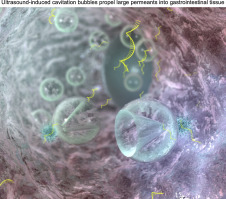Journal of Controlled Release ( IF 10.5 ) Pub Date : 2017-10-16 , DOI: 10.1016/j.jconrel.2017.10.023 Carl M. Schoellhammer , Yiyun Chen , Cody Cleveland , Daniel Minahan , Taylor Bensel , June Y. Park , Sarah Saxton , Young-Ah Lucy Lee , Lucas Booth , Robert Langer , Giovanni Traverso

|
Ultrasound-mediated drug delivery in the gastrointestinal (GI) tract is a bourgeoning area of study. Localized, low-frequency ultrasound has recently been shown to enable significant enhancement in delivery of a broad set of active pharmaceutical ingredients including small molecules, proteins, and nucleic acids without any formulation or encapsulation of the therapeutic. Traditional chemical formulations are typically required to protect, stabilize, and enable the successful delivery of a given therapeutic. The use of ultrasound, however, may make delivery insensitive to the chemical formulation. This might open the door to chemical formulations being developed to address other properties besides the deliverability of a therapeutic. Instead, chemical formulations could potentially be developed to achieve novel pharmacokinetics, without consideration of that particular formulation's ability to penetrate the mucus barrier passively. Here we investigated the effect of permeant size, charge, and the presence of chemical penetration enhancers on delivery to GI tissue using ultrasound. Short ultrasound treatments enabled delivery of large permeants, including microparticles, deep into colonic tissue ex vivo. Delivery was relatively independent of size and charge but did depend on conformation, with regular, spherical particles being delivered to a greater extent than long-chain polymers. The subsequent residence time of model permeants in tissue after ultrasound-mediated delivery was found to depend on size, with large microparticles demonstrating negligible clearance from the local tissue 24 h after delivery ex vivo. The dependence of clearance time on permeant size was further confirmed in vivo in mice using fluorescently labeled 3 kDa and 70 kDa dextran. The use of low-frequency ultrasound in the GI tract represents a novel tool for the delivery of a wide-range of therapeutics independent of formulation, potentially allowing for the tailoring of formulations to impart novel pharmacokinetic profiles once delivered into tissue.
中文翻译:

定义超声介导的胃肠道递送的最佳渗透特性
超声介导的胃肠道药物输送是研究的一个新兴领域。最近已经显示,局部低频超声可以显着增强包括小分子,蛋白质和核酸在内的多种活性药物成分的输送,而无需对药物进行任何配制或封装。通常需要传统的化学制剂来保护,稳定并能够成功递送给定的治疗剂。然而,超声的使用可能使递送对化学制剂不敏感。这可能为正在开发的化学制剂打开大门,以解决除治疗剂的可递送性以外的其他特性。取而代之的是,有可能开发化学制剂以实现新的药代动力学,无需考虑特定配方被动渗透粘液屏障的能力。在这里,我们研究了渗透物的大小,电荷和化学渗透促进剂对使用超声向胃肠道组织递送的影响。短时间的超声波治疗可以将大的渗透物(包括微粒)输送到结肠组织深处离体。递送相对独立于大小和电荷,但确实取决于构象,规则的球形颗粒的递送程度比长链聚合物更大。发现超声介导的递送后模型渗透物在组织中的后续停留时间取决于大小,大颗粒表明离体递送24 h后与局部组织的清除作用可忽略不计。在体内进一步证实清除时间对渗透物尺寸的依赖性在小鼠中使用荧光标记的3 kDa和70 kDa右旋糖酐。胃肠道中低频超声的使用代表了一种新型工具,可用于不依赖于制剂的多种治疗手段的输送,一旦被递送到组织中,就可能允许对制剂进行定制以赋予新的药代动力学特征。











































 京公网安备 11010802027423号
京公网安备 11010802027423号